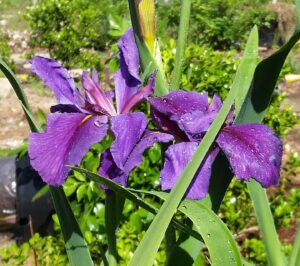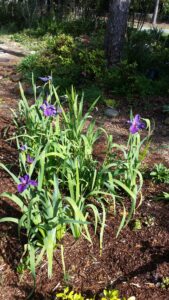S & J Nursery’s Guide to Growing
Fallen Heroes Series
Iris ‘Rocky Hunt’
in our Northeast Florida Landscape
( Louisiana Iris ‘Rocky Hunt’)
 Louisiana Iris ‘Rocky Hunt’ Origins:
Louisiana Iris ‘Rocky Hunt’ Origins:
One of my favorite Louisiana Iris plants for the Northeast Florida landscape. Rocky Hunt is a Hybrid developed by Leann Connelly and is one of many Iris plants in a series named “Fallen Heroes”. I can not tell of these wonderful plants without first telling of their namesake. To skip over this touching tribute to me seems wrong, even on a gardening page.
The ‘Fallen Heroes” Iris plants have been named after public service
members to commemorate the lives they lived. This particular Iris was named after a police officer, James (Rocky) Hunt III. It is, I am sure, every bit as beautiful as the legacy of bravery, selflessness, and sacrifice he left behind him. So for Mr. Hunt all we can ever say is thank you, and for his beautiful family, we remember.
Preferred Exposure of the Fallen Heroes Series Iris ‘Rocky Hunt’ :
– Louisiana Iris can be planted in full sun to part shade.
Foliage:
– Glossy green sword-like foliage stands erect in clumps and adds an instant
tropical feel to the garden or landscape. Deciduous leaves will regrow each spring.
Soil Preference / Salt tolerance:
– Louisiana Iris is quite at home in wet soils to the point of living happily
submerged just below the waterline at the edge of a pond. Just don’t let that fool you, they will tolerate a wider range of soils than just constantly wet with ease. I myself plant them into my very sandy soil garden and amend the soil once to twice each year with a generous top-dressing of compost of composted manure to help the soil hold in some moisture and they just keep sticking around, year after year.
Mature Plant Size:
– 24″ clumping
Growth Habit:
– Boldly upright foliage is a soft grey green when new and a brilliant jade green when mature.
– Plants should be dug and divided every 2 years in early spring for best
flowering.
Growth Rate:
– Louisiana Iris is a fast growing perennial plant.
Blooms of the Fallen Heroes Iris ‘Rocky Hunt’:
– Stunning 5 inch wide blue – purple blooms stand out n the garden. Blooms are held high on the plants just at the tops of the foliage.
Water Requirements:
– Louisiana Iris plants will require regular water to get the plant rooted
and growing on it’s own after being planted in the ground from an S & J Nursery container. When planted into dry soil locations, water daily just after planting for a t least a week or two and weekly to biweekly after that depending on sun exposure after that.
Best Uses For Louisiana Iris Plants in the Northeast Florida | Jacksonville | St. Augustine area Landscape:
– Louisiana Iris plants are at home in any garden setting and blend in
beautifully with surrounding perennial plants and shrubs etc.
– Iris make excellent potted plants and their strongly erect foliage
adds a dramatic flare anywhere they are placed. I love to see them near patios, pools or walkways where the gorgeous blossoms can be appreciated up close.
– Although these plants stand alone beautifully they are also gorgeous
when planted in mass. Perfect in masses under larger trees or landscape specimen plant you want to draw attention to like a birdbath or statue. Massed plantings of Iris will instantly turn a drab tucked away corner
of the yard into a landscape showpiece.
– Great pond side plant selection, or submerged pond planting.
Care of Louisiana Iris Plants:
– Water every day during the establishment period after planting in the garden from an S & J Tree Farm and Nursery container.
– When planted into a location that receives some direct sun or well drained sandy soils, supplemental irrigation is preferred for optimal plant health.
– As with all perennial plantings, amending the soil with compost when planting your Louisiana Iris plants will help keep them healthy and happy through the years.
– Plants should be dug and divided every 2 years in the early spring.
– Fertilize each spring with a shovel full of food quality garden compost or a
mixture of Milorganite or Green Edge Fertilizer and a slow release poly coated plant food such as Osmocote or Stay Green general purpose plant food or 10-10-10.

